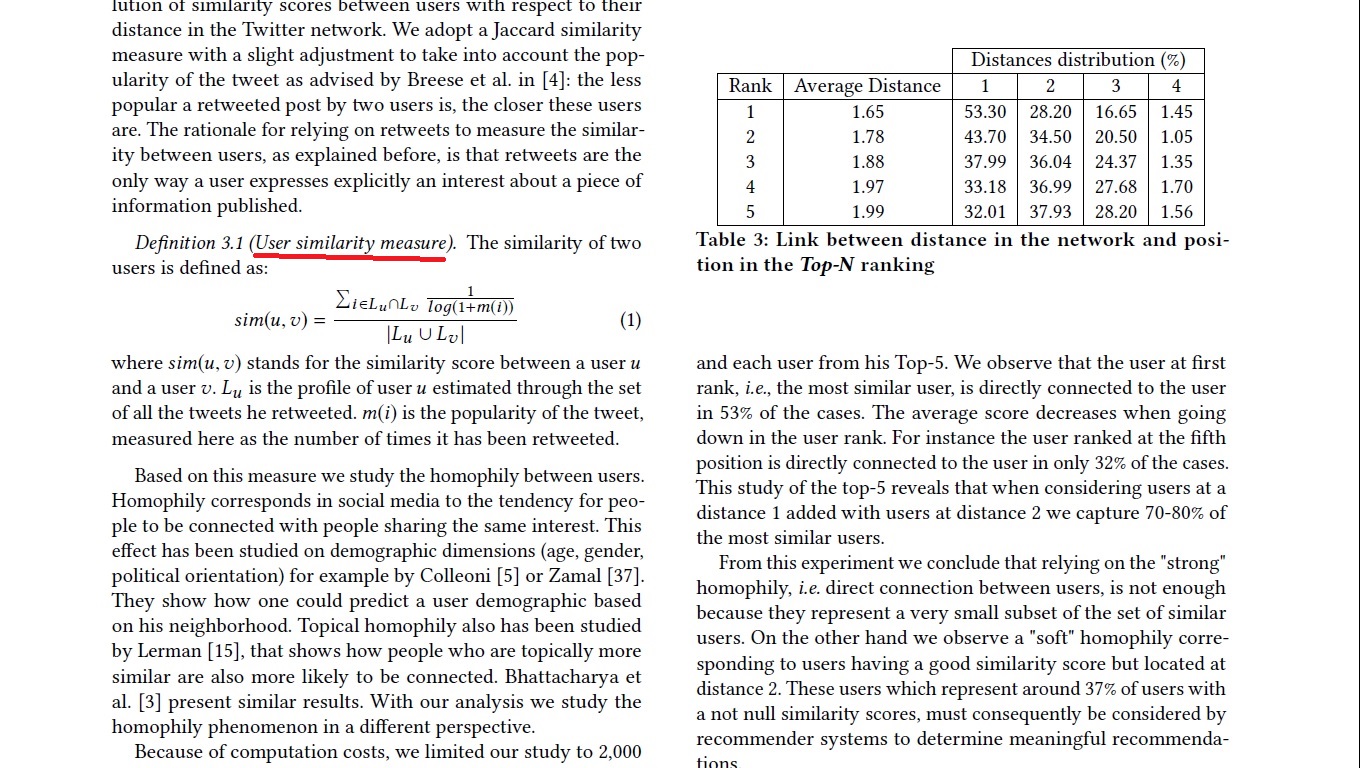
An analysis of dyadic interactions of approximately 65, heterosexual users of an online dating system in the U.S. showed that, despite these differences, users of the system sought people like them much more often than chance would predict, just as in the offline world gay users’ behavior in online dating environments; thus, these users were excluded from the analysis. Within the active subset of users, the median age was 34, but the male population was slightly older (median 36 years, compared to 33 years for women). Most users were Caucasian ( percent); African-Americans and Hispanics Fiore, A.T., and J.S. Donath. "Homophily in Online Dating: When Do You Like Someone Like Yourself?." Short paper, ACM Computer-Human Interaction , Portland, Ore
Homophily In Online Dating When Do You Like Someone Like Yourself - Free PDF eBook
edu no longer supports Internet Explorer. To browse Academia. edu and the wider internet faster and more securely, please take a few seconds to upgrade your browser. Log In with Facebook Log In with Google Sign Up with Apple. Remember me on this computer. Enter the email address you signed up with and we'll email you a reset link. Need an account? Click here to sign up.
Download Free PDF. Homophily in online dating: when do you like someone like yourself? CHI'05 extended abstracts homophily in online dating Human factors …, homophily in online dating, Andrew Fiore. Download PDF Download Full PDF Package This paper. A short summary of this paper. Homophily in Online Dating: When Do You Like Someone Like Yourself?
Andrew T. Fiore and Judith S. Donath MIT Media Laboratory 20 Ames St. This paper attraction and, later, relationship satisfaction. Online dating describes a quantitative examination of the characteristics for systems provide a new way for users to identify and which online dating users seek others like them. communicate with potential partners, homophily in online dating, but the information they provide differs dramatically from what a person might glean NATURE OF ONLINE PERSONALS DATA from face-to-face interaction.
An analysis of dyadic We analyzed data from one online dating system in interactions of approximately 65, heterosexual users of an particular. Through an agreement brokered by the Media online dating system in the U. Anonymous ID numbers distinguished unique build, physical attractiveness, and smoking habits. Author Keywords Table 1 indicates which profile characteristics users could Online personals, attraction, computer-mediated specify about themselves and about the partners they would communication, online dating, relationships like to meet.
Data about private messages exchanged by the users ACM Classification Keywords included the sender, homophily in online dating, recipient, subject, text, date and time of H5.
Group and Organization Interfaces; Asynchronous delivery, and whether the recipient had read the message. interaction; Web-based interaction. Of these, In Augustpersonals Web sites fully completed their profiles. A slightly different subset, in the United States drew 40 million unique visitors — half Mulrine the eight-month study period — that is, they sent or These online personal ads have shed their stereotype as received at least one message. This active subset was used matchmakers for the awkward and now claim a prominent role for analyses of messaging behavior, but for analyses in the social lives of millions of users.
Researchers have involving profile characteristics, it was limited to the Although the Site has a national base of users, they are distributed differently from the U. population on a state- by-state basis. CHIApril 2—7,Portland, Oregon, USA. certain secondary urban areas in the West, such as Sacramento, Calif. However, homophily in online dating, most of these exchanges were Gender Cat.
something less than dyadic: conversations consisted of unreciprocated single messages. Height Con. Messages were received in a more even distribution than they Location city, state, postal code Cat. Users sent and received a mean of 1. The means are Smoking habits Cat. the same because the same bounded population sent and received the messages. However, the standard deviation for Educational level Cat.
number of messages sent was 7. number of messages received, indicating that messages were How many children user wants Buck. distributed more evenly across the set of recipients than they Marital status Cat, homophily in online dating. were across the set of senders.
In total, 29, homophily in online dating, users sent Pets owned Cat. Pets preferred Cat. Of exchanges between a man and a woman, men initiated Self-rated physical attractiveness Buck, homophily in online dating. the majority of conversations percent ; however, their initiations were likely to be reciprocated than those begun by women percent reciprocated vs, homophily in online dating. Importance of height in a partner Buck.
Users of both sexes had homophily in online dating with a median of 2. Profile attributes specified by users about themselves for women.
Men participated in more communications on and about their preferences in a partner average than women, but we would expect this because the active subset of users contains more women than men, homophily in online dating, so the contacts are spread across a larger number of women.
The overall user population on the Site included more men Overall, the number of dyadic ties per person followed the few ties and exponentially fewer with many ties. The mean The Site targets heterosexual users; although it allows users number of ties per person was 5. to specify same-sex preferences e. Because homosexual users were so few, their vs. these users were excluded from the analysis. years, compared to 33 years for women.
Most users were Some characteristics are more bounding than others — that Caucasian For example, smokers might want to find population.
Nearly 10 percent chose not to give their race. other smokers more so than people with blue eyes want to find other people with blue eyes. We would say that For additional demographic descriptors of this data set, smoking is more strongly bounding than eye color because including religion, marital status, number of children, people with a given smoking status are less likely to cross educational level, smoking habits, drinking habits, physical the boundary to choose someone with a different smoking build, and physical attractiveness, consult Fiore status than someone with brown eyes would be to choose a partner with blue eyes.
categorical characteristic both for all pairwise exchanges and separately for the subset of reciprocated exchanges. Analytic Approach The absolute value of the difference between the actual On the Site, to involve two users of athletic build. However, if users of An actual sameness percentage close to its expected athletic build sought other such users more often, the sameness percentage indicates that users homophily in online dating share a value percentage of contacts involving two of these users would for that characteristic did not communicate more often than exceed 3.
other randomly. On the other hand, a large difference By summing the probability of sameness across all possible between actual and expected sameness percentages would values of a homophily in online dating, we find an overall probability that indicate that users who share a value for a characteristic a random pair of one male and one female user homophily in online dating share communicated more often than we would expect by chance.
the same value for that characteristic. These overall Because we expect statistically a varying likelihood of probabilities are listed in Table 2 as Expected percent same.
sameness for various characteristics, the absolute difference The expected sameness for a characteristic varies with the in expected and actual percentages does not facilitate number of values possible for that characteristic and how comparisons homophily in online dating different characteristics, which have evenly users are distributed among the values. Expected different expected percentages. Characteristic same x contacts, a1 con. of children appearance Bounding strength of categorical characteristics.
Expected percent same indicates the statistically expected percentage of dyadic pairs who share the same value for the listed characteristic.
The expected probability is based on random selection from the male and female population distributions for the characteristic. Actual percent same indicates the homophily in online dating percentage of dyadic pairs who shared the same value for the listed characteristic, across all contacts and just the reciprocated subset, in which the initial recipient replied.
It might relative bounding strength of each. also be true that having similar religiosity is more important than sharing a specific religion cf. Findings Users opted for sameness more often than chance would The overwhelming majority of dyads This the same race, but, as with drinking habits, this high rate of similarity is only moderately better than chance 14 percent. concurs with the overwhelming evidence gathered by Because Brehm et al.

Homophily in online dating: When do you like someone like yourself. blogger.com Read/Download File Report Abuse. Introduction to the special issue Online dating - Budrich Journals An analysis of dyadic interactions of approximately 65, heterosexual users of an online dating system in the U.S. showed that, despite these differences, users of the system sought people like them much more often than chance would predict, just as in the offline world Fiore, A.T., and J.S. Donath. "Homophily in Online Dating: When Do You Like Someone Like Yourself?." Short paper, ACM Computer-Human Interaction , Portland, Ore

Keine Kommentare:
Kommentar veröffentlichen